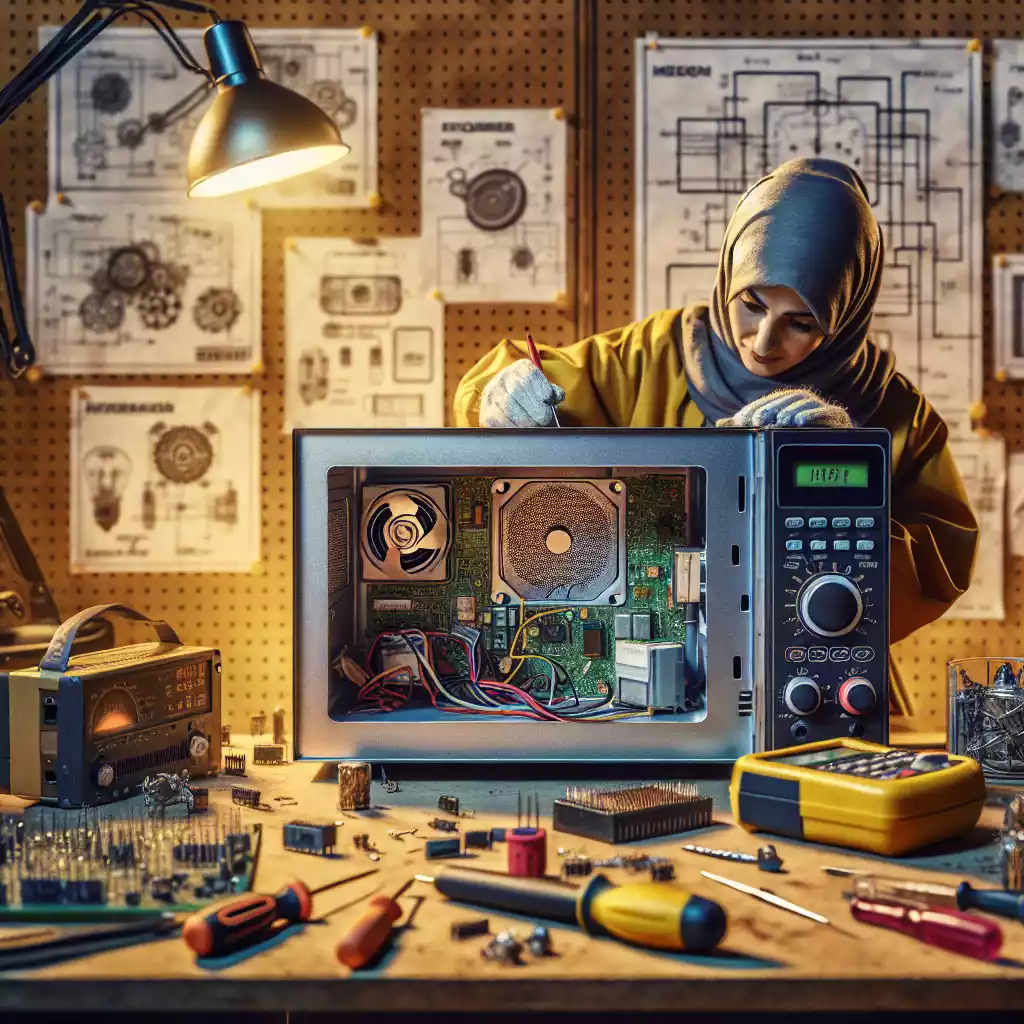Understanding Microwave Technology
Basics of Microwave Operation
Microwaves have revolutionized cooking since their commercial introduction in the late 1940s. They work by using microwave radiation to heat food. This radiation excites water molecules in the food, causing them to vibrate and produce heat. This process allows for quick and efficient cooking.
Common Components of a Microwave
Microwaves consist of several key components:
• Magnetron: Generates the microwaves.
• Waveguide: Channels the microwaves from the magnetron to the cooking chamber.
• Turntable: Ensures even cooking by rotating the food.
• Control Panel: Allows users to set cooking times and power levels.
• High Voltage Capacitor: Stores electrical energy to power the magnetron.
Common Microwave Issues
Microwave Not Heating
A microwave that doesn’t heat is one of the most common problems. This issue often stems from a faulty magnetron, diode, or capacitor. Diagnosing the exact cause requires a multimeter to test these components.
Turntable Not Rotating
If the turntable isn’t rotating, the problem could be a broken turntable motor or a faulty drive bushing. These parts can be replaced with basic tools and a bit of patience.
Safety Precautions for Microwave Repair

Importance of Unplugging the Microwave
Before starting any repair, always unplug the microwave. This simple step prevents electric shock and ensures your safety.
Handling High Voltage Capacitors
Microwave capacitors store a dangerous amount of electricity even after the microwave is unplugged. Discharging the capacitor safely is crucial to avoid injury. Use a well-insulated screwdriver to short the terminals of the capacitor, ensuring it is fully discharged.
Diagnosing Microwave Problems
Identifying Electrical Issues
Electrical issues often manifest as the microwave not powering on or not heating. Using a multimeter, you can check the continuity of the fuse, diode, and magnetron to identify the faulty component.
Detecting Mechanical Failures
Mechanical failures, such as a non-rotating turntable or a door that won’t latch, are usually easier to diagnose. Inspect the turntable motor, drive bushing, and door switch for visible damage or wear.
Repairing Electrical Components
Replacing a Faulty Magnetron
A faulty magnetron is a common culprit when a microwave stops heating. To replace it:
1. Unplug the microwave and discharge the capacitor.
2. Remove the outer casing to access the magnetron.
3. Disconnect the magnetron from the power supply and mounting screws.
4. Install the new magnetron and reassemble the microwave.
Fixing a Damaged Diode
A damaged diode can prevent the microwave from heating. To replace it:
1. Unplug the microwave and discharge the capacitor.
2. Locate the diode near the capacitor.
3. Disconnect the old diode and replace it with a new one.
Repairing Mechanical Components
Fixing a Broken Turntable Motor
A broken turntable motor can cause uneven cooking. To replace it:
1. Unplug the microwave.
2. Remove the turntable and the motor cover.
3. Disconnect the motor and replace it with a new one.
Replacing a Faulty Door Switch
A faulty door switch can prevent the microwave from operating. To replace it:
1. Unplug the microwave.
2. Remove the control panel to access the door switch.
3. Disconnect the old switch and install the new one.
When to Call a Professional
Assessing the Complexity of the Issue
Some issues, like a broken magnetron or capacitor, can be complex and dangerous to repair. If you’re not confident in your ability to fix the problem, it’s best to call a professional.
Evaluating Cost vs. Replacement
Consider the cost of repair versus the cost of a new microwave. If the repair costs more than half the price of a new microwave, it might be more economical to replace the unit.
Preventive Maintenance Tips
Regular Cleaning and Maintenance
Regular cleaning prevents food buildup, which can cause odors and reduce efficiency. Wipe down the interior after each use and clean the turntable and waveguide cover regularly.
Avoiding Common User Mistakes
Avoid running the microwave empty, as this can damage the magnetron. Also, use microwave-safe containers to prevent sparks and fires.
FAQs
FAQ 1: How do I know if my microwave is worth repairing?
Assess the age, condition, and repair cost. If the microwave is relatively new and the repair cost is reasonable, it’s worth fixing.
FAQ 2: Can I repair my microwave if it’s under warranty?
Check the warranty terms. Many warranties cover specific repairs, and attempting to fix it yourself might void the warranty.
FAQ 3: What tools do I need for microwave repair?
Basic tools include a multimeter, insulated screwdriver, and needle-nose pliers. Specific repairs might require additional tools.
FAQ 4: Are there any microwave parts that should not be repaired by amateurs?
Yes, components like the magnetron and capacitor store high voltage and can be dangerous. It’s best to leave these repairs to professionals.
FAQ 5: How long does a typical microwave repair take?
Simple repairs, like replacing a turntable motor, can take under an hour. More complex repairs might take several hours or require professional assistance.
Conclusion
Repairing a microwave can be a cost-effective solution for common issues. By understanding the technology, diagnosing problems, and following safety precautions, many repairs can be done at home. However, always consider the complexity and potential dangers before attempting any repairs. If in doubt, consulting a professional is the safest option.

